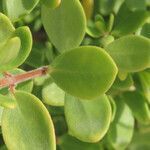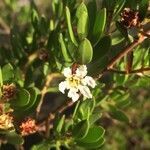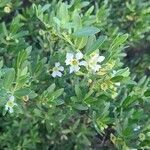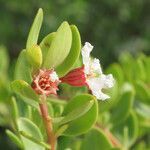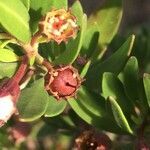Shrubs to densely branched, spreading trees, maritime, small, to 11 m tall, but often ca. 1 m. Stems and branchlets ascending; branchlets, young leaves, and inflorescences densely silky grayish white strigose. Leaves opposite, sessile or subsessile; petiole to 2 mm; leaf blade narrowly elliptic to lanceolate, 1-3 cm × 5-15 mm, thick, succulent, base attenuate, apex often terminating in a minute circular hydathode. Flowers solitary or paired, axillary, 6-merous, actinomorphic, heteromorphic, distylous; pedicel 5-13 m. Floral tube 4-5 mm, turbinate, 12-ribbed, thick walled, densely grayish white strigose; sepals short, ca. 1/4 as long as floral tube; epicalyx segments equaling sepals or ca. 1/2 as long. Petals 6, white or pale pink, obovate to suborbicular, 3-5 mm. Stamens 12, scarcely biseriate, 6 exserted in short-styled thrum flowers, all included in long-styled pin flowers. Ovary vestigially 3-or 4-loculed, appearing 1-loculed with free central placentation at maturity; ovules ascending on short placenta; style long-exserted in pin flowers, included in thrum flowers; stigma capitate. Capsules dry, circumscissile, obovoid, ca. 6 mm, slightly exserted at maturity. Seeds ca. 20, irregularly obpyramidal, not winged, 2-3 mm. 2n = 32.
More
Shrub or small tree to 11 m tall, hoary, silky-tomentose. Leaves subsucculent, ovate to oblong, obtuse, attenuate basally and subsessile; lamina 1–3 cm long. Peduncle 5–13 mm long. Hypanthium campanulate, 3–5 mm deep; appendages shorter than sepals. Sepals triangular, c. 0.5 mm long. Petals orbicular to obovate, 4–5 mm long, white, sometimes tinged with pink. Stamens 12, included to slightly exserted. Ovary 3-locular below, 1-locular above, heterostylous. Capsule globose, 3–5 mm diam.; dehiscence circumscissile.
A shrub or small tree. It can grow to 2-10 m high and spread 1.5-6 m wide. The trunk is gnarled and grey. Young growth has grey silky hairs. The bark is brown and flaky. The small branches are angular. The leaves are small, fleshy and oval. They are 1.3-2.5 cm long by 0.3-0.7 cm wide. They are opposite and grey-green. The flowers are small and white. They have 6 papery petals. The flower is almost enclosed in a reddish ring of the outer sepals. The fruit is a capsule 0.7 cm across. It is red.
Sandy shores, at or even below high-water mark, inlets in mangrove forests, coral-rag thicket; in areas exposed to salt spray and the drier sides of swamps. Coastal limestone rocks, cliffs, and on limestone bedrock outcrops on atolls.
More
It is a tropical plant. It grows on coastal limestone rocks and on atolls. It is common on the inner margins of mangroves. It occurs on Pacific atolls.
